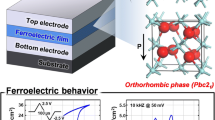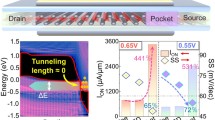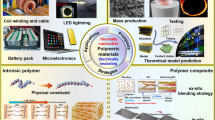Abstract
Titanium dioxide (TiO2) thin films were synthesized by sol–gel process followed by post-deposition heat treatment using rapid thermal annealing (RTA) to improve the film quality. TiO2 thin films were annealed at various temperatures ranging from 500 to 900 °C for 1–10 min in air and oxygen ambient. The uniform distribution of grains has been studied by analyzing field emission scanning electron microscope micrographs. The structural studies were carried out by X-ray diffraction and Raman spectroscopy technique which have confirmed the presence of anatase and rutile phase after annealing at 700 °C. The maximum values of oxide charge density (Qox) and interface charge density (Dit) were calculated as 2.58 × 1012 cm−2 and 2.31 × 1012 eV−1 cm−2 at 900 °C and 2.19 × 1012 cm−2 and 1.53 × 1012 eV−1 cm−2 at 700 °C, for 10 min annealing duration in air ambient, respectively. The resistive switching studies have shown better switching performance at 700 °C for 10 min in air ambient with current on/off ratio of 40. Moreover, for films RTA processed at 700 °C for 5 min in air and oxygen ambient the current on/off ratios were found to be 836 and 140, respectively.

Highlights
-
TiO2 thin films synthesized by the dip-coating method were processed in rapid thermal annealing (RTA) system.
-
RTA temperatures were varied from 500 °C–900 °C for 1 min to 10 min in air and oxygen ambient.
-
Uniform distribution of grains and improved crystallinity were observed from FESEM micrographs, XRD and Raman studies for the film processed at 700 °C.
-
The maximum values of oxide charge density (Qox) and interface charge density (Dit) were obtained at 900 °C for 10 min annealing duration in air ambient.
-
In memristor study, the maximum current on/off ratio was obtained for films RTA processed at 700 °C for 5 min in air ambient.


















Similar content being viewed by others
References
Chen X, Mao SS (2007) Titanium dioxide nanomaterials: synthesis, properties, modifications and applications. Chem Rev 107:2891–2959. https://doi.org/10.1021/cr0500535
Aljawfi RN, Vij A, Chae KH, Dalela S, Alvi PA, AL-Maghrabi MA, Kumar S (2018) Effects of rapid thermal annealing on the local environment, electronic structure and magnetic properties of Mn doped TiO2 thin films. Appl Surf Sci 445:287–297. https://doi.org/10.1016/j.apsusc.2018.03.138
Haider AJ, Jameel ZN, Al-Hussaini IH (2019) Review on: titanium dioxide applications. Energy Procedia 157:17–29. https://doi.org/10.1016/j.egypro.2018.11.159
Watanabe T, Nakajima A, Wang R, Minabe M, Koizumi S, Fujishima A, Hashimoto K (1999) Photocatalytic activity and photoinduced hydrophilicity of titanium dioxide coated glass. Thin Solid Films 351:260–263. https://doi.org/10.1016/S0040-6090(99)00205-9
Wang Z, Hu X (1999) Fabrication and electrochromic properties of spin-coated TiO2 thin films from peroxo-polytitanic acid. Thin Solid Films 352:62–65. https://doi.org/10.1016/S0040-6090(99)00321-1
Brown WD, Grannemann WW (1978) C-V characteristics of metal-titanium dioxide-silicon capacitors. Solid State Electron 21:837–846. https://doi.org/10.1016/0038-1101(78)90308-8
Waser R, Dittmann R, Staikov C, Szot K (2009) Redox-based resistive switching memories nanoionic mechanisms, prospects, and challenges. Adv Mater 21:2632–2663. https://doi.org/10.1002/adma.200900375
Huang YJ, Chao SC, Lien DH, Wen CY, He JH, Lee SC (2016) Dual-functional memory and threshold resistive switching based on the push-pull mechanism of oxygen ions. Sci Rep. 6:1–10. https://doi.org/10.1038/srep23945
Xia Q, Robinett W, Cumbie MW, Banerjee N, Cardinali TJ, Yang JJ, Wu W, Li X, Tong WM, Strukov DB, Snider GS, Medeiros-Ribeiro G, Williams RS (2009) Memristor-CMOS hybrid integrated circuits for reconfigurable logic. Nano Lett 9:3640–3645. https://doi.org/10.1021/nl901874j
Strukov DB, Snider GS, Stewart DR, Williams RS (2008) The missing memristor found. Nature 453:80–83. https://doi.org/10.1038/nature06932
Jeong HY, Lee JY, Ryu MK, Choi SY (2010) Bipolar resistive switching in amorphous titanium oxide thin film. Phys Status Solidi 4:28–30. https://doi.org/10.1002/pssr.200903383
Zhu Y, Li M, Zhou H, Hu Z, Liu X, Fang X, Sebo B, Fang G, Zhao X (2012) Nonvolatile bipolar resistive switching in an Ag/TiO2/Nb: SrTiO3/In device. J Phys D Appl Phys 45:7. https://doi.org/10.1088/0022-3727/45/37/375303
Sahu DP, Jammalamadaka SN (2017) Remote control of resistive switching in TiO2 based resistive random access memory device. Sci Rep 7:1–8. https://doi.org/10.1038/s41598-017-17607-4
Gale E, Pearson D, Kitson S, Adamatzky A, De Lacy Costello B (2015) The effect of changing electrode metal on solution-processed flexible titanium dioxide memristors. Mater Chem Phys 162:20–30. https://doi.org/10.1016/j.matchemphys.2015.03.037
Kar JP, Lee SW, Lee W, Myoung JM (2008) Effect of sputtered films on morphology of vertical aligned ZnO nanowires. Appl Surf Sci 254:6677–6682. https://doi.org/10.1016/j.apsusc.2008.04.046
Shim JH, Hu Q, Park MR, Abbas Y, Kang CJ, Kim J, Yoon TS (2015) Resistive switching characteristics of TiO2 thin films with different electrodes. J Korean Phys Soc 67:936–940. https://doi.org/10.3938/jkps.67.936
Biju KP, Liu X, Bourim EM, Kim I, Jung S, Park J, Hwang H (2010) Improved resistive switching properties of solution processed TiO2 thin films. Electrochem Solid-State Lett 13:443–446. https://doi.org/10.1149/1.3494433
Biju KP, Liu X, Bourim EM, Kim I, Jung S, Siddik M, Lee J, Hwang H (2010) Asymmetric bipolar resistive switching in solution-processed Pt/TiO2/W devices. J Phys D Appl Phys 43:5. https://doi.org/10.1088/0022-3727/43/49/495104
Senthilkumar V, Kathalingam A, Valanarasu S, Kannan V, Rhee JK (2013) Bipolar resistive switching of solution processed TiO2-graphene oxide nanocomposite for nonvolatile memory applications. Phys Lett A 377:2432–2435. https://doi.org/10.1016/j.physleta.2013.07.018
Cao X, Li X, Yu W, Liu X, He X (2009) Bipolar resistive switching properties of microcrystalline TiO2 thin films deposited by pulsed laser deposition. Mater Sci Eng B 157:36–39. https://doi.org/10.1016/j.mseb.2008.12.005
Ma WJ, Lin SP, Luo JM, Zhang XY, Wang Y, Li ZX, Wang B, Zheng Y (2013) Highly uniform bipolar resistive switching characteristics in TiO2/BaTiO3/TiO2 multilayer. Appl Phys Lett 103. https://doi.org/10.1063/1.4852695
Zhang W, Kong JZ, Cao ZY, Li AD, Wang LG, Zhu L, Li X, Cao YQ, Wu D (2017) Bipolar resistive switching characteristics of HfO2/TiO2/HfO2 trilayer-structure RRAM devices on Pt and TiN-coated substrates fabricated by atomic layer deposition. Nanoscale Res Lett 12:1–11. https://doi.org/10.1186/s11671-017-2164-z
Hirose S, Nakayama A, Niimi H, Kageyama K, Takagi H (2011) Improvement in resistance switching and retention properties of Pt∕TiO2 Schottky junction devices. J Electrochem Soc 158:H261. https://doi.org/10.1149/1.3529247
Chen Y, Xu J, Xie S, Tan Z, Nie R, Guan Z, Wang Q, Zhu J (2018) Ion doping effects on the lattice distortion and interlayer mismatch of aurivillius-type bismuth titanate compounds. Materials 11. https://doi.org/10.3390/ma11050821
Kim WG, Rhee SW (2009) Effect of post annealing on the resistive switching of TiO2 thin film. Microelectron Eng 86:2153–2156. https://doi.org/10.1016/j.mee.2009.02.028
Baszczuk A, Jasiorski M, Winnicki M (2018) Low-temperature transformation of amorphous Sol–Gel TiO2 powder to anatase during cold spray deposition. J Therm Spray Technol 27:1551–1562. https://doi.org/10.1007/s11666-018-0769-0
Liu HC, Tang XG, Liu QX, Jiang YP, Li WH, Bin Guo X, Tang ZH (2020) Bipolar resistive switching behavior and conduction mechanisms of composite onanostructured TiO2/ZrO2 thin film. Ceram Int. https://doi.org/10.1016/j.ceramint.2020.05.201
Tian Y, Zhang J, Ma JC, Jia X (2012) Monodisperse rutile microspheres with ultrasmall nanorods on surfaces: synthesis, characterization, luminescence, and photocatalysis. J Colloid Interface Sci 385:1–7. https://doi.org/10.1016/j.jcis.2012.06.086
Tubío CR, Guitián F, Salgueiro JR, Gil A (2015) Anatase and rutile TiO2 monodisperse microspheres by rapid thermal annealing: a method to avoid sintering at high temperatures. Mater Lett 141:203–206. https://doi.org/10.1016/j.matlet.2014.11.063
Sulka GD, Kapusta-Kołodziej J, Brzózka A, Jaskuła M (2010) Fabrication of nanoporous TiO2 by electrochemical anodization. Electrochim Acta 55:4359–4367. https://doi.org/10.1016/j.electacta.2009.12.053
Jiang X, Herricks T, Xia Y (2003) Monodispersed spherical colloids of titania: synthesis, characterization, and crystallization. Adv Mater 15:1205–1209. https://doi.org/10.1002/adma.200305105
Chen D, Cao L, Huang F, Imperial P, Cheng YB, Caruso RA (2010) Synthesis of monodisperse mesoporous titania beads with controllable diameter, high surface areas, and variable pore diameters (14-23 nm). J Am Chem Soc 132:4438–4444. https://doi.org/10.1021/ja100040p
Yu J, Zhao X, Du J, Chen W (2000) Preparation, microstructure and photocatalytic activity of the porous TiO2 anatase coating by sol-gel processing. J Sol-Gel Sci Technol 17:163–171. https://doi.org/10.1023/A:1008703719929
Ali I, Suhail M, Alothman ZA, Alwarthan A (2018) Recent advances in syntheses, properties and applications of TiO2 nanostructures. RSC Adv 8:30125–30147. https://doi.org/10.1039/c8ra06517a
Schwartz RW, Schneller T, Waser R (2004) Chemical solution deposition of electronic oxide films. Comptes Rendus Chim 7:433–461. https://doi.org/10.1016/j.crci.2004.01.007
Boudrioua A, Chakaroun M, Fischer A (2017) In: An introduction to organic lasers. Elsevier, UK
Sahu N, Parija B, Panigrahi S (2009) Fundamental understanding and modeling of spin coating process: a review. Indian J Phys 83:493–502. https://doi.org/10.1007/s12648-009-0009-z
Brinker CJ, Frye GC, Hurd AJ, Ashley CS (1991) Fundamentals of sol-gel dip coating. Thin Solid Films 201:97–108. https://doi.org/10.1016/0040-6090(91)90158-T
Chen D, Wu HKY, Naderi-Gohar S, Wu Y, Huang Y, Nie HY (2014) An extremely rapid dip-coating method for self-assembly of octadecylphosphonic acid and its thermal stability on an aluminum film. J Mater Chem C 2:9941–9948. https://doi.org/10.1039/c4tc02017k
Núñez CG, Navaraj WT, Liu F, Shakthivel D, Dahiya R (2018) Large-area self-assembly of silica microspheres/nanospheres by temperature-assisted dip-coating. ACS Appl Mater Interfaces 10:3058–3068. https://doi.org/10.1021/acsami.7b15178
Gayler MLV (1938) Melting point of high-purity silicon. Nature 142:478. https://doi.org/10.1038/142478a0
Plummer JD (2009) In:Silicon VLSI technology: fundamentals, practice and modeling. Pearson Education, India
Yoo WS, Fukada T, Yokoyama I, Kang K, Takahashi N (2002) Thermal behavior of large-diameter silicon wafers during high-temperature rapid thermal processing in single wafer furnace. Jpn J Appl Phys 41:4442–4449. https://doi.org/10.1143/JJAP.41.4442
Kern W (1993) In: Handbook of semiconductor wafer cleaning technology. Noyes Publication, New Jersey, pp 111–196
Roy S, Tripathy N, Pradhan D, Sahu PK, Kar JP (2018) Electrical characteristics of dip coated TiO2 thin films with various withdrawal speeds for resistive switching applications. Appl Surf Sci 449:181–185. https://doi.org/10.1016/j.apsusc.2018.01.207
Algueró M, Calzada ML, Quintana C, Pardo L (1999) Ferroelectricity of lanthanum-modified lead titanate thin films obtained by a diol-based sol-gel method. Appl Phys A Mater Sci Process 68:583–592. https://doi.org/10.1007/s003390050945
Thakurdesai M, Sulania I, Narsale AM, Kanjilal D, Bhattacharyya V (2008) Formation of TiO2 nanorings due to rapid thermal annealing of swift heavy ion irradiated films. J Nanosci Nanotechnol 8:4387–4394. https://doi.org/10.1166/jnn.2008.284
Kim J-W, Kim D-O, Hahn Y-B (1998) Effect of rapid thermal annealing on the structural and electrical properties of TiO2 thin films by plasma enhanced CVD, Korean. J Chem Eng 15:217–222. https://doi.org/10.1088/1757-899X/178/1/012009
Bakri AS, Sahdan MZ, Adriyanto F, Raship NA, Said NDM, Abdullah SA, Rahim MS (2017) Effect of annealing temperature of titanium dioxide thin films on structural and electrical properties. AIP Conf Proc 1788. https://doi.org/10.1063/1.4968283
Chao S, Petrovsky V, Dogan F (2010) Effects of sintering temperature on the microstructure and dielectric properties of titanium dioxide ceramics. J Mater Sci 45:6685–6693. https://doi.org/10.1007/s10853-010-4761-4
Usui H, Domi Y, Yoshioka S, Kojima K, Sakaguchi H (2016) Electrochemical lithiation and sodiation of Nb-doped rutile TiO2, ACS sustain. Chem Eng 4:6695–6702. https://doi.org/10.1021/acssuschemeng.6b01595
Ishigaki T, Nakada Y, Tarutani N, Uchikoshi T, Tsujimoto Y, Isobe M, Ogata H, Zhang C, Hao D (2020) Enhanced visible-light photocatalytic activity of anatase-rutile mixed-phase nano-size powder given by high-temperature heat treatment. R Soc Open Sci 7. https://doi.org/10.1098/rsos.191539
Comert B, Akin N, Donmez M, Saglam S, Ozcelik S (2016) Titanium dioxide thin films as methane gas sensors. IEEE Sens J 16:8890–8896. https://doi.org/10.1109/JSEN.2016.2619860
Zhang Q, Li C (2020) High temperature stable anatase phase titanium dioxide films synthesized by mist chemical vapor deposition. Nanomaterials 10. https://doi.org/10.3390/nano10050911
Gregory DG, Lu L, Kiely CJ, Snyder MA (2017) Interfacial stabilization of metastable TiO2 films. J Phys Chem C 121:4434–4442. https://doi.org/10.1021/acs.jpcc.6b12943
Phromma S, Wutikhun T, Kasamechonchung P, Eksangsri T, Sapcharoenkun C (2020) Effect of calcination temperature on photocatalytic activity of synthesized TiO2 nanoparticles via wet ball milling sol-gel method. Appl Sci 10. https://doi.org/10.3390/app10030993
Vu NH, Le HV, Cao TM, Pham VV, Le HM, Nguyen-Manh D (2012) Anatase-rutile phase transformation of titanium dioxide bulk material: a DFT+U approach. J Phys Condens Matter 24. https://doi.org/10.1088/0953-8984/24/40/405501
Kars I, Çetin SŞ, Kinaci B, Sarikavak B, Bengi A, Altuntaş H, Öztürk MK, Özçelik S (2010) Influence of thermal annealing on the structure and optical properties of d.c. magnetron sputtered titanium dioxide thin films. Surf Interface Anal 42:1247–1251. https://doi.org/10.1002/sia.3373
Grzmil B, Gleń M, Kic B, Lubkowski K (2013) Study of the anatase to rutile transformation kinetics of the modifi ed TiO2, Polish. J Chem Technol 15:73–80. https://doi.org/10.2478/pjct-2013-0026
Hanaor DAH, Sorrell CC (2011) Review of the anatase to rutile phase transformation. J Mater Sci 46:855–874. https://doi.org/10.1007/s10853-010-5113-0
Shannon RD, Pask JA (1965) Kinetic of the anatase-rutile transformation. J Am Ceram Soc 48:391–398. https://doi.org/10.1111/j.1151-2916.1965.tb14774.x
Sotillo B, Ariza R, Siegel J, Solis J, Fernández P (2020) Preferential growth of ZnO micro- and nanostructure assemblies on Fs-laser-induced periodic structures. Nanomaterials 10:1–13. https://doi.org/10.3390/nano10040731
Choudhury B, Choudhury A (2013) Local structure modification and phase transformation of TiO2 nanoparticles initiated by oxygen defects, grain size, and annealing temperature. Int Nano Lett 3:1–9. https://doi.org/10.1186/2228-5326-3-55
Nicollian EH, Brews JR (1982) In: MOS (metal oxide semiconductor) physics and technology. John Wiley & Sons, New Jersey
Hill CC, Coleman WA (1980) A single-frequency approximation for interface-state density determination. Solid State Electron 23:987–993. https://doi.org/10.1016/0038-1101(80)90064-7
Huang JY, Lin CY, Shen CH, Shieh JM, Dai BT (2012) Low cost high-efficiency amorphous silicon solar cells with improved light-soaking stability. Sol Energy Mater Sol Cells 98:277–282. https://doi.org/10.1016/j.solmat.2011.11.023
Harvey SP, Johnston S, Teeter G (2016) Effects of voltage-bias annealing on metastable defect populations in CIGS and CZTSe solar cells. In: 2016 IEEE 43rd photovoltaic specialists conference (PVSC), pp 2169–2173. https://doi.org/10.1109/PVSC.2016.7750018
Cammarata RC (1994) Surface and interface stresses. Prog Surf Sci 46:1–38. https://doi.org/10.1016/0079-6816(94)90005-1
Spaepen F (2000) Interfaces and stresses in thin films. Acta Mater 48:31–42. https://doi.org/10.1016/S1359-6454(99)00286-4
Moridi A, Ruan H, Zhang LC, Liu M (2013) Residual stresses in thin film systems: effects of lattice mismatch, thermal mismatch and interface dislocations. Int J Solids Struct 50:3562–3569. https://doi.org/10.1016/j.ijsolstr.2013.06.022
O’Sullivan BJ, Hurley PK, Leveugle C, Das JH (2001) Si(100)-SiO2 interface properties following rapid thermal processing. J Appl Phys 89:3811–3820. https://doi.org/10.1063/1.1343897
Yang C, Fan H, Qiu S, Xi Y, Chen J (2008) Effects of thermal expansion coefficient mismatch on structure and electrical properties of TiO2 film deposited on Si substrate. Surf Rev Lett 15:487–491. https://doi.org/10.1142/S0218625X08011639
Nasim F, Ali A, Hafizuddin M, Bhatti AS (2012) Role of Ti phases in the modulation of border traps at the TiO2/n-Si interfaces. J Appl Phys 112:2–7. https://doi.org/10.1063/1.4747839
Chowdhury P, Barshilia HC, Selvakumar N, Deepthi B, Rajam KS, Chaudhuri AR, Krupanidhi SB (2008) The structural and electrical properties of TiO2 thin films prepared by thermal oxidation. Phys B Condens Matter 403:3718–3723. https://doi.org/10.1016/j.physb.2008.06.022
Regonini D, Adamaki V, Bowen CR, Pennock SR, Taylor J, Dent ACE (2012) AC electrical properties of TiO2 and Magnéli phases, TinO2n-1. Solid State Ion 229:38–44. https://doi.org/10.1016/j.ssi.2012.10.003
Le Page Y, Strobel P (1982) Structural chemistry of the Magnéli phases TinO2n-1, 4 ≤ n ≤ 9. II. Refinements and structural discussion. J Solid State Chem 44:273–281. https://doi.org/10.1016/0022-4596(82)90374-7
Liborio L, Harrison N (2008) Thermodynamics of oxygen defective Magnéli phases in rutile: a first-principles study. Phys Rev B 77:1–10. https://doi.org/10.1103/PhysRevB.77.104104
Abbas Y, Han IS, Sokolov AS, Jeon YR, Choi C (2020) Rapid thermal annealing on the atomic layer-deposited zirconia thin film to enhance resistive switching characteristics. J Mater Sci Mater Electron 31:903–909. https://doi.org/10.1007/s10854-019-02598-x
Yang XY, Zhu YK, Miura H, Sakai T (2010) Static recrystallization behavior of hot-deformed magnesium alloy AZ31 during isothermal annealing. Trans Nonferrous Met Soc China 20:1269–1274. https://doi.org/10.1016/S1003-6326(09)60289-2
Tian M, Mahjouri-Samani M, Wang K, Puretzky AA, Geohegan DB, Tennyson WD, Cross N, Rouleau CM, Zawodzinski TA, Duscher G, Eres G (2017) Black anatase formation by annealing of amorphous nanoparticles and the role of the Ti2O3 shell in self-organized crystallization by particle attachment. ACS Appl Mater Interfaces 9:22018–22025. https://doi.org/10.1021/acsami.7b02764
Haider AJ, Taha SY, Jameel ZN (2014) Synthesis of TiO2 nanoparticles by using sol-gel method and its applications as antibacterial agents. Eng Tech J 32:418–426. 16816900 24120758
Gergel-hackett N, Hamadani B, Dunlap B, Suehle J, Member S, Richter C, Member S, Hacker C, Gundlach D (2009) A flexible solution-processed memristor. IEEE Electron Device Lett 30:706–708. https://doi.org/10.1109/LED.2009.202141
Pham KN, Hoang VD, Tran CV, Phan BT (2016) TiO2 thin film based transparent flexible resistive switching random access memory. Adv Nat Sci Nanosci Nanotechnol 7. https://doi.org/10.1088/2043-6262/7/1/015017
Ye C, Deng T, Zhang J, Shen L, He P, Wei W, Wang H (2016) Enhanced resistive switching performance for bilayer HfO2/TiO2 resistive random access memory. Semicond Sci Technol 31:1–7. https://doi.org/10.1088/0268-1242/31/10/105005
Huang CH, Chou TS, Huang JS, Lin SM, Chueh YL (2017) Self-selecting resistive switching scheme using TiO2 nanorod arrays. Sci Rep 7:1–9. https://doi.org/10.1038/s41598-017-01354-7
Xiao M, Musselman KP, Duley WW, Zhou NY (2017) Resistive switching memory of TiO2 nanowire networks grown on ti foil by a single hydrothermal method. Nano-Micro Lett 9:1–9. https://doi.org/10.1007/s40820-016-0116-2
Emel’yanov AV, Demin VA, Antropov IM, Tselikov GI, Lavrukhina ZV, Kashkarov PK (2015) Effect of the thickness of the TiOx/TiO2 layers on their memristor properties. Tech Phys 60:112–115. https://doi.org/10.1134/S1063784215010077
Author information
Authors and Affiliations
Corresponding author
Ethics declarations
Conflict of interest
The authors declare that they have no conflict of interest.
Additional information
Publisher’s note Springer Nature remains neutral with regard to jurisdictional claims in published maps and institutional affiliations.
Rights and permissions
About this article
Cite this article
Roy, S., Ghosh, S.P., Pradhan, D. et al. Investigation of morphological and electrical properties of RTA-processed TiO2 for memristor application. J Sol-Gel Sci Technol 96, 702–717 (2020). https://doi.org/10.1007/s10971-020-05395-9
Received:
Accepted:
Published:
Issue Date:
DOI: https://doi.org/10.1007/s10971-020-05395-9




